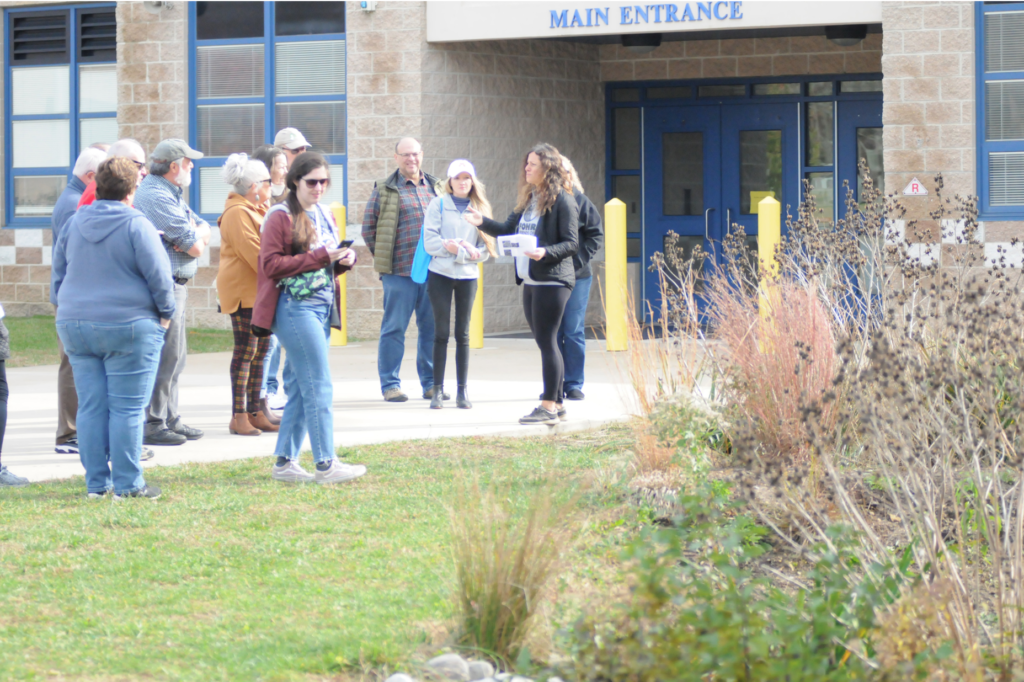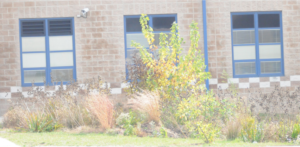 The New Jersey Department of Education (NJDOE) includes climate change in its new curriculum. Changes were implemented in September 2021.
The New Jersey Department of Education (NJDOE) includes climate change in its new curriculum. Changes were implemented in September 2021.

New Jersey League of Conservation Voters took interested people on a tour of Hammonton rain gardens in November 2021. One of the stops was the rain garden at Hammonton High School. Photo credit: Dan Russoman
According to the NJDOE’s website, “On June 3, 2020, the State Board of Education adopted the 2020 New Jersey Student Learning Standards (NJSLS) in the following content areas: Career Readiness, Life Literacies and Key Skills; Comprehensive Health and Physical Education; Computer Science & Design Thinking; Science; Social Studies; Visual and Performing Arts; and World Languages.
“These standards truly represent a foundation from which districts will build coherent curriculum and instruction that prepares each New Jersey student with the knowledge and skills to succeed in our rapidly changing world. They will put New Jersey again at the forefront of national education by including the following:
“Climate Change across all content areas, leveraging the passion students have shown for this critical issue and providing them opportunities to develop a deep understanding of the science behind the changes and to explore the solutions our world desperately needs.”
In the Hammonton School District, students are learning about sustainability with hands-on activities such as using the rain garden at the high school.
“We have the rain garden that was put in front of the high school that deals with sustainability and prior to COVID we had classes that went out there and we’re working with that,” Superintendent of Schools Robin Chieco said.

A late fall view of the rain garden at Hammonton High School. Photo credit: Dan Russoman
The idea of the rain garden was brought to the school district because of draining issues at the high school and was made possible through a grant program at Rutgers.
“When we first got it, the kids were able to take care of it, but then last year because of COVID and having the kids not in person all the time, our kids couldn’t really do it. The Hammonton Environmental Club came in and took care of it for us. It was very nice of them, and they work with our kids to try and identify what’s a weed, what’s a plant because that can be sometimes hard to identify,” Chieco said.
Another hands-on learning activity is the pollinator garden at the retention basin between the two elementary schools, but due to the pandemic, plans got “derailed.”
“Hopefully in the near future we’ll be able to go out there and use that area,” Chieco said.
There is also a proposed wellness trail at the Early Childhood Education Center, which will have a science area, Chieco added.
“And of course we have the solar project, which provides hands on science experiments where we can do calculations about renewable energy resources, things like that,” Chieco said.
When it comes to learning about sustainability, a lot of the discussions occur in the science classes and the topic has become more prevalent.

According to Chieco, Jen Gauntt, a 7th grade science teacher at the Hammonton Middle School, is one of the district’s teachers educating students about the environment and sustainability.
“I think the students are more involved with it because this is their generation, and this is the call I think for the younger generation. We need to save the planet. I think it’s more prevalent, topical at this point, so it lends itself to these discussions and things like that in the classroom,” Chieco said.
Teaching students about climate change and sustainability early is important because it helps them develop environmentally friendly routines and habits.
“If you’re taught not to litter, you’re never going to litter. I just think it’s some of the routines and habits that you get into at an early age that stay and go with you throughout your entire life,” Chieco said.
At the Hammonton School District, students learn about plants and butterflies, but as they get older, they will learn more in-depth topics, like the water cycle, through engaging lessons.
“As a former science teacher, science is engaging because it’s hands-on. It’s not something you can just read about in a book; you can actually experience it. Environmental science specifically is something you can see every day, so I think that lends itself to engagement. And again, as we get rid of some of the COVID restrictions and we’re able to go back to a more normal school day, I think we’ll see a lot more of those applications applied,” Chieco said.
Because of the new standards in the curriculum, there have been additions and a “whole new section on the environment and sustainability.”
“Especially in a farming community like Hammonton, it’s important the students understand sustainability, and the importance of taking care of the land and the air and the water supply, because this is the livelihood for many of our families,” Chieco said.
Amy Menzel, the communications manager for the Atlantic County Utilities Authority (ACUA) and the chair of the Hammonton Green Committee, is not an educator but knows there are resources teachers can access for their students.
“At ACUA, we do virtual tours and lessons for kids of all ages at no cost. It’s an easy, fun way to learn about recycling, renewable energy, wastewater and other related topics,” Menzel wrote in an email.
Outside of the classroom, Menzel said there are other ways students can get involved and make a difference in the community.
“The Green Committee is a great way for students to connect with service opportunities. We love to hear what people care about and always welcome ideas for new initiatives,” Menzel wrote.
Menzel said she’s “impressed by teachers that find ways to relate relevant real-life experiences into their lessons.”
“It takes some creative thinking, but these topics can definitely be worked into almost any subject area. For example, a recycling lesson could have students do a waste audit, weighing different types of material and doing the math to determine what percentage of the waste total is recycled, and making observations about what they see—what is being thrown away that could be recycled and what items are mistakenly put in the trash. A graphic design class or art class can create posters or flyers to highlight problems and solutions (what goes where, how to recycle); media students can create videos to do that too,” Menzel wrote.
Both Chieco and Menzel agree that students are learning more about climate change and sustainability than previous generations.
“Students are exposed to a lot more of this kind of information both in class and on their daily lives. Environmental issues effect all of us, and young people especially will have to deal with the consequences as our climate continues to change,” Menzel wrote.
For more information about sustainability, visit ACUA.com or the Hammonton Green Committee’s website at hammontongreencommittee.com.
This story was produced in collaboration with Civic Story (www.civicstory.org) and the NJ Sustainability Reporting project (www.srhub.org).
